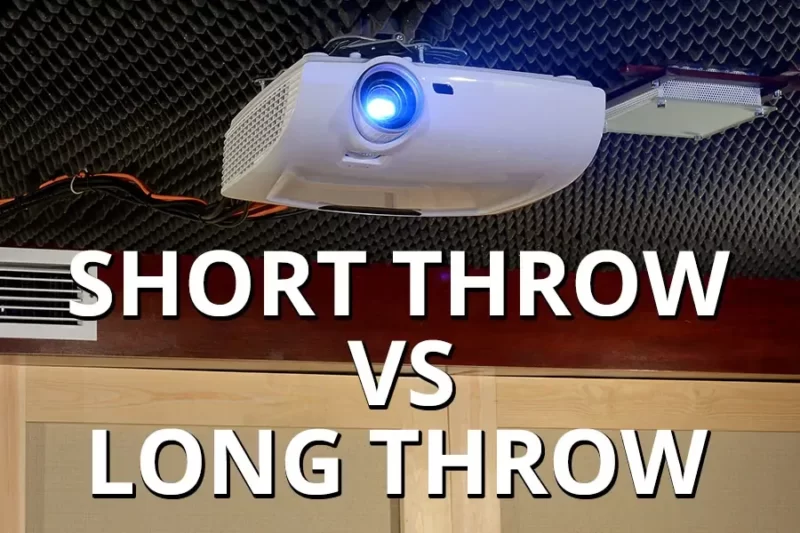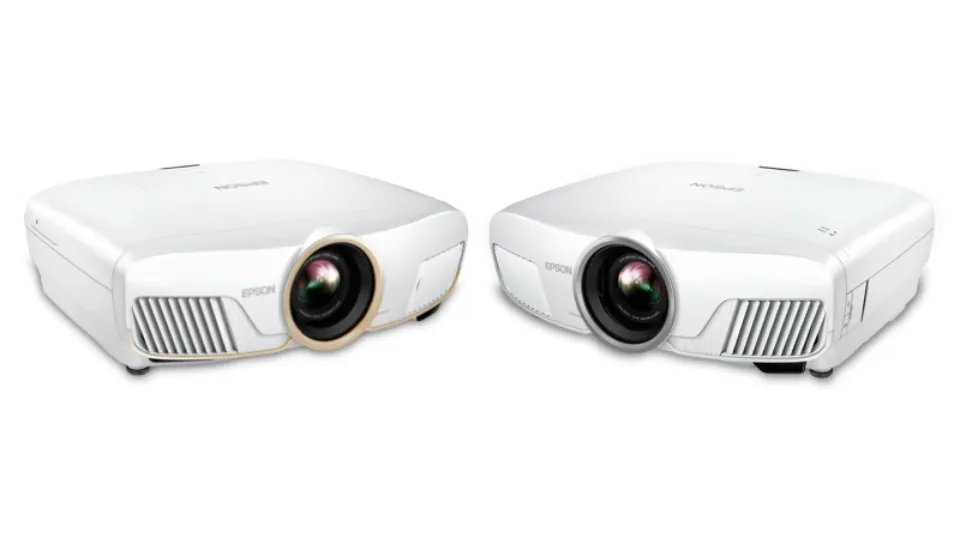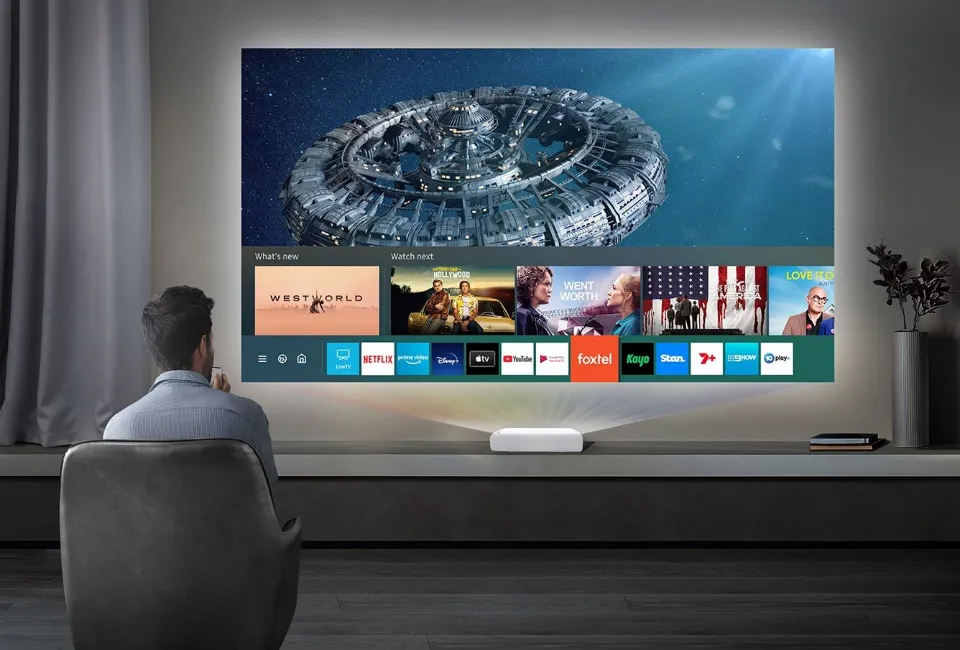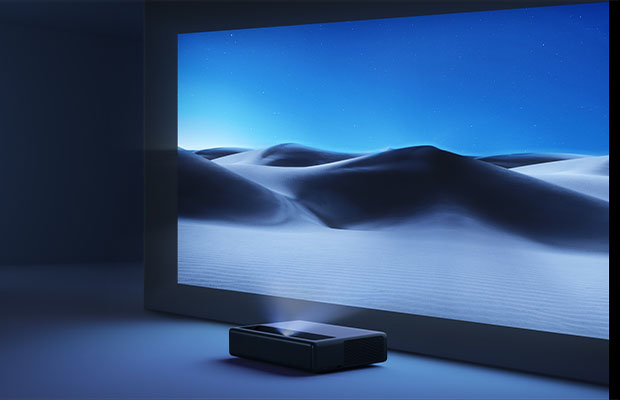Have you tried buying a projector? When it comes to purchasing a new projector, customers need to consider some new and different factors. Since projectors come in short, long, and ultra-short throws, you might want to know the difference so you can get the exact model you need.
Table of Contents
What is a Throw?
Most people don’t know what a throw is, and it’s normal. Throws are almost always overlooked by consumers because they’re not the most obvious feature of a projector, unless, of course, you turn it on in a store.
The throw is the distance the projector needs to “throw” the image onto the screen or wall. There are three types of throws, short throw, long throw, and ultra-short throw. Usually, you’ll know what type of throw it is by checking the model number of the device. If it ends in “ST”, it’s likely a short ball. But be careful, because throwing letters doesn’t always exist.
Three Kinds of Throws
Below is a brief description of each throw so you can decide which one is right for you.
- 1. Short Throw
The Short Throw model was able to create a 100-inch-sized image four feet from the screen. Beyond four feet, you get a slightly blurry image. If you place the projector at a distance of fewer than four feet, your pictures will be sharper and larger.
Because of the short distance between the projector and the screen, short transmissions work well, making it best for small conference rooms and home theaters. They can also be placed in bedrooms and living rooms, depending on the space and stand where the projector is placed. If you’re looking for a projector that you can keep in the comfort of your bedroom, a short-throw projector is likely a more suitable projector. Also, they are much smaller and more compact.
- 2. Long-Throw
Long-Throw projectors are suitable for longer distances. It’s ideal for distances of 6 feet or more. If you place the projector less than six feet away, you’ll get a smaller image, which certainly doesn’t help if you’re projecting in a large room.
Long-Throw is easier to manufacture and has more affordable lenses. If you compare short and long distances, the latter is always cheaper. Of course, this comes at a price. Since Long-Throw should be installed at least six feet away, there is more space between the projector and the screen where people can move around. If the projector is on the table, you can expect someone to block it if they’re on their way to the bathroom or to buy popcorn.
- 3. Ultra-Short Throw
Ultra-Short Throw is less common than long and short throws. This is because this model is designed to be used in very narrow areas.
Ultra-short throws should be no more than 15 inches away from the screen. That’s a very short distance! It’s almost as long as a ruler. This might come in handy if you have a very short room, but otherwise, it’s not as flexible if you’re going to move it off the screen.
Difference Between Short Throw and Long Throw Projectors?
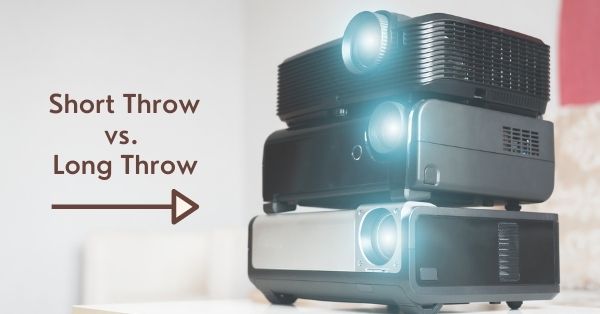
Quite simply, the difference between short-range and long-range projectors is how far from the screen you want to set them. Long throw projectors should be away from the projection surface, while short throw projectors should be close to the projection surface.
Since short-throw projectors are designed to be closer to the screen they project onto, they have a chip that modifies the geometry of their projected image so that angular projections appear as normal rectangles on the projection surface.
This extra processing can cause the short-throw projector to generate excess heat relative to the long-throw projector.
Long-distance projectors perform best when farther away from the screen they are projecting on. This can be an advantage if you have a large home theater environment, or if the power supply is far from where you want the projection surface to be.
Short Throw Projectors
Short throw projectors have a throw ratio between 0.4 and 1. This means that for every foot from the projection surface, the projector will step back and the width of the projected image will increase by 1 to 2.5 feet. (To calculate this scaling factor, divide it by the throw ratio.)
- Pros
There are many advantages to owning a short-throw projector. For starters, a short-throw projector can save space. For a short-throw projector with a throw ratio of 0.4, a four-foot-wide screen can project just 1’7″ from the projection surface. This means there are no annoying shadows when people watch getting up to go to the toilet.
Because they can project from such a short distance, short-throw projectors are ideal for projecting from behind the screen, reducing the chance of the projector being knocked over by a passing person.
- Cons
Short-throw projectors are likely to become hot due to the extra processing power required to convert a rectangular image into a trapezoid capable of projecting a rectangle at an angle. When this happens, the internal fan kicks in to cool the unit, making unnecessary noise.
Also, since the projector will distort the image to be projected at an angle, projecting on an uneven surface will result in more image distortion than a long-distance projector.
Long Throw Projectors
Long-distance projectors have a throw ratio greater than 1, so the width of the projected image is always smaller than the distance between the projector and it. This has several advantages over short-throw projectors, but also some disadvantages.
- Pros
As the name suggests, long-distance projectors can project images over longer distances, so long-distance projectors are a great option when the screen isn’t where the power is. They can also be a great resource if your room’s foot traffic is closer to the screen.
If you’re projecting outdoors, long-distance projectors will reduce image distortion if placed on an uneven surface. The same can be said for projection onto uneven surfaces.
Since long-throw projectors don’t require the geometric transformation of the image like short-throw projectors, they are generally more moderately priced given similar other specs.
- Cons
The most annoying thing about projectors in general, especially long-distance ones, is the shadows that people (and possibly wildlife) block on the screen. Because long-range projectors are meant to project great distances, they are more likely to be blocked by objects on the road.
As a backlight, long-distance projectors take up a large portion of the available space in a home theater space. Also, long-distance projectors are more prone to glare since the projector’s angle can be fixed with additional keystone correction (our guide).
What Should You Buy?
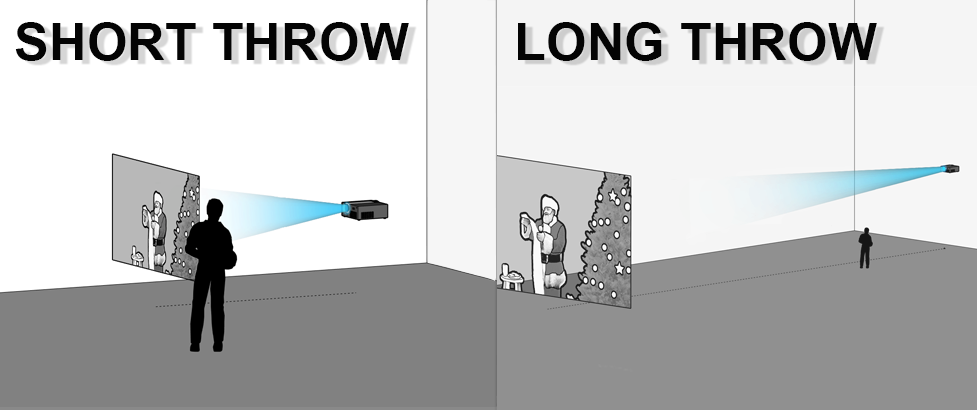
Deciding which projector is right for you depends on many factors. Three important factors you should consider are the home theater space, the location of the projector, and the expected screen size.
The characteristics of a space, including power supply and room curvature, will affect which projector, for example, a home theater or commercial projector, is a topic we explored earlier, which is right for your home theater system.
Whether you plan to install the projector or place it on the floor also affects your decision. Short- and long-throw projectors behave differently with different screen sizes.
Choosing the right projector is a matter of balancing your preferences, which comes down to your personal taste. There is no perfect way to set up a home theater; this is the way that works best for you.
Space
When setting up anything in your home theater, the first consideration is the space you set up. The curvature in the room helps to indicate a good location for the projection surface and the location of the projector. Power also affects which projector you should use.
First, you want to make sure your projection surface won’t get glare from outside light. You’ll want your seating area to pass straight through the projection surface, with enough room for your speakers to surround symmetrically. See this guide for information on how to arrange your speakers.
If you’re working in a small room, you’ll probably want a short-throw projector, as the long-distance might not give you the screen size you want. If you have a lot of free space and need a large screen, then a long-distance projector might be more suitable for your purpose.
Screen Size
Screen size will be determined by the ceiling height and viewing area. Not limited by vertical space, you want the screen height to be 1/6 the distance from the farthest part of the viewing area. However, this height may be limited by the ceiling of the room.
The screen should be about three feet off the ground for comfortable viewing. Just subtract three feet from the ceiling height of the room and you can get the maximum height of the screen. Choose the lower of these two numbers as the maximum height.
The closest part of the viewing area should be no less than two screen heights away. To get the width, multiply the screen height by the aspect ratio of the projector’s projection.
Placement
Another thing to consider is where you plan to place the projector. One thing to consider is whether you want to mount the projector on a wall or ceiling, on a shelf, or sit on the floor.
Another thing to consider if you have space behind your projection surface is the possibility of getting a translucent screen and putting the projector behind it.
While mounting the projector ensures that the image is projected correctly every time, not mounting the projector gives you the option to move the projector. This is perfect for showing movies on one side of the house on those warm summer nights.
The size of the screen you need and the throw ratio of the projector will determine how far from the screen you have to place the projector. Just multiply the screen width by the throw ratio to get the proper projector-to-screen distance.
This may determine where you place your viewing area and whether you choose to install a projector.
Final Words
Whether you’re looking for a short-throw projector, a long-throw projector, or an ultra-short-throw projector, our guide will give you the technical knowledge you need to make an informed decision about purchasing the right projector model for you. 4k projectors are the most popular right now. Remember, this is mostly about image size and image quality based on throw distance. This will determine the type of projector you are looking at.

